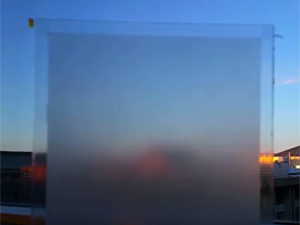



Date:21/04/16
 Curtains and blinds may soon be a design choice as opposed as to a tool for privacy. Windows that can transition between clear and cloudy in a second may soon be a reality thanks to technology under development at Harvard University's School of Engineering.
Curtains and blinds may soon be a design choice as opposed as to a tool for privacy. Windows that can transition between clear and cloudy in a second may soon be a reality thanks to technology under development at Harvard University's School of Engineering.
Windows that can change opacity or color already exist but rely on electrochemical reactions that are expensive to manufacture, especially on a commercial scale.
"They are all very effective, although I think ours is even more effective. But the big problem is how you create large areas, windows, and the cost," said Professor David Clarke, a material scientist at Harvard.
The scientists have figured out a method to produce windows that go from clear to cloudy at the flip of a switch in a way that is both cost effective and commercially viable, according to a study they published in the journal Optical Letters.
The team uses elastomer rubber coated with nanowires that adheres to glass to scatter light when voltage is applied.
"When you apply a voltage to them relative to some background there is an attractive force between the nanowires and the substrate that deforms the elastomer," said Clarke. "Elastomer rubber is very soft and so the surface becomes rough, and it is that roughness that scatters light," Clarke added.
Samuel Shian, an author on the study, believes scaling this technology should be commercially viable because the reaction is physical rather than chemical. Current chemical-based controllable windows use vacuum deposition to coat the glass, an expensive process that deposits layers of a material molecule by molecule.
But to transition this technology to the real world will take a bit more fine tuning in the lab, according to Shian.
"When we are talking about windows we are talking about several feet by several feet...we are talking from small to large, so things need to be optimized," he said.
One obstacle is developing a thinner elastomer that would require lower voltages to deform.
Harvard has filed a patent application on the technology.
No more curtains thanks to next generation window technology
 Curtains and blinds may soon be a design choice as opposed as to a tool for privacy. Windows that can transition between clear and cloudy in a second may soon be a reality thanks to technology under development at Harvard University's School of Engineering.
Curtains and blinds may soon be a design choice as opposed as to a tool for privacy. Windows that can transition between clear and cloudy in a second may soon be a reality thanks to technology under development at Harvard University's School of Engineering.Windows that can change opacity or color already exist but rely on electrochemical reactions that are expensive to manufacture, especially on a commercial scale.
"They are all very effective, although I think ours is even more effective. But the big problem is how you create large areas, windows, and the cost," said Professor David Clarke, a material scientist at Harvard.
The scientists have figured out a method to produce windows that go from clear to cloudy at the flip of a switch in a way that is both cost effective and commercially viable, according to a study they published in the journal Optical Letters.
The team uses elastomer rubber coated with nanowires that adheres to glass to scatter light when voltage is applied.
"When you apply a voltage to them relative to some background there is an attractive force between the nanowires and the substrate that deforms the elastomer," said Clarke. "Elastomer rubber is very soft and so the surface becomes rough, and it is that roughness that scatters light," Clarke added.
Samuel Shian, an author on the study, believes scaling this technology should be commercially viable because the reaction is physical rather than chemical. Current chemical-based controllable windows use vacuum deposition to coat the glass, an expensive process that deposits layers of a material molecule by molecule.
But to transition this technology to the real world will take a bit more fine tuning in the lab, according to Shian.
"When we are talking about windows we are talking about several feet by several feet...we are talking from small to large, so things need to be optimized," he said.
One obstacle is developing a thinner elastomer that would require lower voltages to deform.
Harvard has filed a patent application on the technology.
Views: 679
©ictnews.az. All rights reserved.Similar news
- The mobile sector continues its lead
- Facebook counted 600 million active users
- Cell phone testing laboratory is planned to be built in Azerbaijan
- Tablets and riders outfitted quickly with 3G/4G modems
- The number of digital TV channels will double to 24 units
- Tax proposal in China gets massive online feedback
- Malaysia to implement biometric system at all entry points
- Korea to build Green Technology Centre
- Cisco Poised to Help China Keep an Eye on Its Citizens
- 3G speed in Azerbaijan is higher than in UK
- Government of Canada Announces Investment in Green Innovation for Canada
- Electric cars in Azerbaijan
- Dominican Republic Govt Issues Cashless Benefits
- Spain raises €1.65bn from spectrum auction
- Camden Council boosts mobile security





















